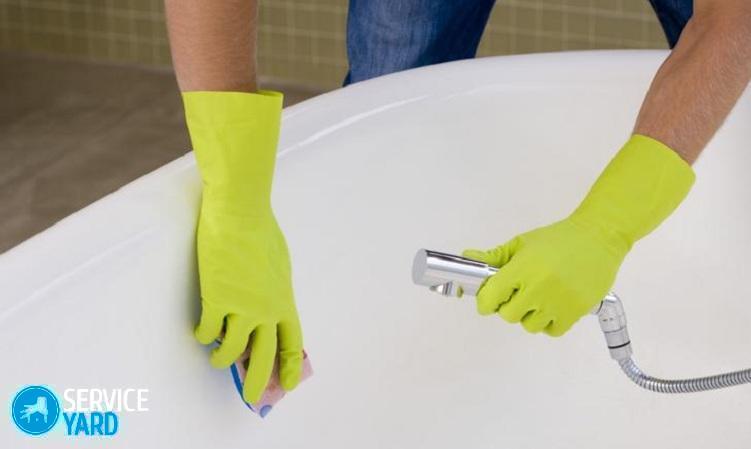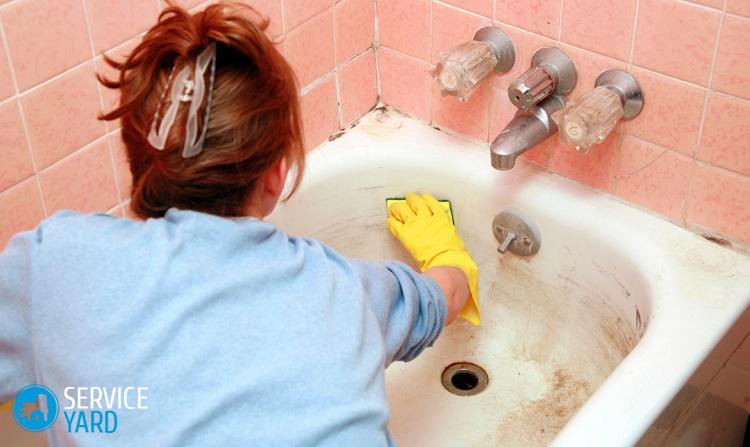How to clean the bath at home with baking soda and vinegar?
The cleanliness of the bathroom must be perfect. But very often, regardless of the frequency of use and the accuracy of the owners, plumbing loses its former beauty and becomes covered with ugly spots. How to clean the bath at home with baking soda and vinegar? This and some other effective methods for cleaning a plumbing item are described in our article. By putting into practice simple and effective tips, your bath will regain its original appearance.
Causes of bath pollution and solutions to the problem
Over time, even the most expensive and high-quality plumbing loses its luster and snow-white cleanliness. Limescale settles on surfaces many times faster from frequent showering. What can we say about taking a bath. Poor quality water, lack of proper care for plumbing, long service life are among the main causes of bath pollution. Agree that unattractive rusty spots, plaque on the surface, the faded color of plumbing not only spoil the reputation of the owners, but also give reason to doubt the sanitation of the whole house.
In order to solve this problem, there are several options:
- Replace all plumbing with new;
- Give to the masters for restoration;
- Clean the bath with baking soda and vinegar;
- Use special household chemicals.
Today, the department of household chemicals presents a huge range of products, with the help of which, according to the packaging, you can easily cope with any contamination - plaque, rust, soap stains, and so on. But few people know and use the old time-tested method - to wash the bath from yellow plaque at home with soda and vinegar. A tool prepared from these components is able to restore the shine, cleanliness of even too dirty plumbing. It is about this cleaning option that we will talk further.
How to clean the bath with baking soda?
Plumbing, like all other interior items, needs constant care - this is one of the most important conditions for maintaining cleanliness and hygiene in the house. For cleaning, there is no need to purchase expensive liquids that contain caustic and abrasive substances. At home, you can clean the bath with ordinary or soda ash.
Benefits of cleaning the bathtub with baking soda:
- Baking soda is excellent at removing fresh traces of rust and plaque.
- The product can be safely used on products with enamel coating.
- The substance is an excellent antiseptic. By treating the surface with it, you can easily eliminate harmful microorganisms, unpleasant odors, and prevent the formation of fungus.
- Periodic cleaning of plumbing with soda will reduce cleaning time, save the family budget and will not harm your health.
- Sodium bicarbonate is harmless and does not cause allergies, does not leave burns upon contact with human skin.
Important! To ensure complete safety, rubber gloves should still be worn during cleaning.

Cleaning method:
- Treat the contaminated surface with a small amount of soda.
- Using a stiff brush, thoroughly rub the product.
- Leave the product for a better effect for 1-1.5 hours.
- After the time has elapsed, wash off the soda with warm water.
- For better and more effective surface cleaning, use citric acid. Dilute it with water in proportion to 0.5 liters of water 1 tablespoon of acid.
- First of all, apply soda, rub with a brush, after 10-20 minutes wipe the surfaces with a solution of citric acid.
- Leave the product for another 30 minutes, at the end, rinse everything thoroughly with warm water.
How to clean a bathtub with vinegar?
With the problem of plaque and rusty formations on the surface of the bath, vinegar will also effectively cope - a product that is always at hand in every home. Using vinegar for cast-iron bathtubs, the luster of plumbing is restored with a slight movement, dirt of varying complexity is removed.
Processing way:
- Wetting small areas of the surface with liquid is a rather tedious and time-consuming task. To speed up the process, you need to moisten large napkins and cover the entire bath inside with them.
- Leave the product for 2-3 hours for the best effect.
- After the time has elapsed, remove the napkins, and rinse the bath thoroughly with warm water.
How to clean rust stains on the bathroom with vinegar?
The appearance of rusty formations on the bathroom for the most part depends on the condition of our sewerage. Water, passing through old pipes, leaves imperceptible traces on the surface, which over time turn a new bath into an old and not aesthetic plumbing. With the help of a solution of vinegar, you can get rid of stubborn rusty stains.
Cleaning option #1:
- Vinegar is heated in a pan with table salt to a temperature of 50 degrees.
- Using a sponge or brush, apply a small amount to the rust.
- Leave the product on for 30 minutes.
- Finally, wipe the treated area with a damp cloth.
Cleaning option #2
- Fill the tub with hot water. up to the level of contaminants.
- Pour about 600 ml of table 9% vinegar into the water.
- Leave the water with vinegar for 4 hours.
- Finally, scrub thoroughly with a brush and rinse with water.
Important! To keep your plumbing fixtures shiny and clean longer, wipe them with vinegar after every bath. After such treatment, be sure to rinse the surfaces with cold water.
How to clean the bath with soda ash?
The properties of soda ash are significantly different from ordinary soda, which we use for cooking or cleaning light dirt. Soda ash has an increased alkaline balance. In the home, it is used to wash and remove more stubborn stains and chronic defects.
Important! The raw material, unlike baking soda, is a strong cleaning agent, so be sure to wear protective gloves when working with it, and also take precautions.
There are a large number of recipes for preparing a liquid for washing a bath with soda ash, which are easy to prepare at home. The result after the cleaning will delight you, and you can easily find all the necessary components for preparing the product at home.
Method number 1
You will need:
- Laundry soap (grated or crushed).
- Soda ash and baking soda.
- Ammonia.
Cleaning sequence:
- Mix in a small container in a 1: 1 ratio of a mixture of soap and soda.
- Add 3-5 drops of ammonia.
- Pour in water and stir thoroughly until all ingredients are completely dissolved.
- Treat contaminated areas with the resulting composition.
- Leave the remedy for 2 hours.
- Finally, rinse with plenty of running water.

Method number 2
The second method involves the use of household soda in combination with vinegar. So how do you clean a bathtub with soda ash and vinegar?
You will need:
- Baking soda and soda ash.
- Bleach.
- Table vinegar 9%.
Processing sequence:
- In a small bowl, mix equal parts baking soda and soda ash.
- In this container, add the same amount of bleach and table vinegar. Stir thoroughly until a homogeneous mixture is formed.
- Next, the resulting slurry is applied to the contaminated area of the bathroom, left on the surface for 20 minutes.
Important! To achieve a faster and better result, stains are treated with a solution of bleach and vinegar and left for another 30 minutes.
- Finally, thoroughly scrub the treated area with a brush and rinse off the remaining substance with warm water.
Option number 3
Bleach is added during the washing process in order to enhance the effect of the powder. In our case, in order to enhance the effect of baking soda or soda ash, it is also necessary to use bleach. To prepare the following remedy, you will need:
- "White".
- Soda ash.
Cleaning sequence:
- First of all, we clean the bath with soda, then apply bleach on the cleaned surface and leave for 20-30 minutes.
Important! After the time has elapsed, the bath will be washed off from visible rusty smudges and the enamel will regain its whiteness.
- Finally, rinse thoroughly with cold running water.
Important! It is not recommended to use this cleaning method more than 2-3 times a month. "Whiteness" in its composition is a chemical - the vapors emitted by the liquid are very harmful to health.
In order not to run into a problem in the future and not look for options on how to clean the bath at home with soda, vinegar or bleach, we recommend that you remember a few practical tips regarding bathroom care:
- After every bath or shower, rinse the tub with warm water and pat dry with a towel.
Important! Make sure that all family members adhere to this rule.
- To avoid the appearance of rusty smudges and plaque on the coating, wash it as it gets dirty.
- It is recommended to wash the bath no more than 4 times a month. Acrylic products should be washed no more than once a month.
Important! When using household chemicals for cleaning, strictly follow the instructions on the package, otherwise you can damage such a delicate surface.
- In the department of household chemicals, purchase products specifically designed for a particular type of bath.
- Enameled plumbing is strictly forbidden to be cleaned with metal brushes, as well as treated with products that contain acids.
Important! These components destroy the coating, and, unfortunately, it will not be possible to restore it.
- Manufacturers do not recommend acrylic coating of bathtubs to be treated with abrasive substances, such as baking soda and washing powder, alcohol-containing liquids, gasoline, acetone, and liquids containing chlorine will also have to be excluded.
Timely care of the bathroom will allow you to maintain the original brilliance and novelty of all parts, as well as extend their life. Use the recommendations from the article to clean the bath with soda ash and vinegar, and your plumbing will shine clean for a long time, and taking a bath will bring real pleasure.






